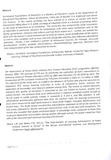| dc.description.abstract | In an academic field, research project and/or thesis is an integral and mandatory component of the higher degree programmes. The guidelines on how to write research proposals are therefore expected to assist a student to identify and choose a viable research problem. Many research proposals are turned down each year because of content and methodological deficiencies. The research proposal serves to present the research question or problem to be researched on; discuss its importance to society; the research efforts of others who have worked on related research; suggests sources of data pertinent to solving the research question and how the data will be gathered, analysed and interpreted. A good research proposal is concise and focused although its length is dependent on regulations of different universities; it often ranges between ten and forty double-spaced pages inclusive of appendices. A research proposal has three main chapters or sections namely introduction, titerature review and research methodology.
Kibera, loW. and Kibera F.N. (2009). Guidelines for Writing Academic Research Projects in Fountain, Journal of Faculty of Education, November 3, pp 117-129.
Abstract
The social changes being experienced worldwide cannot be overemphasized. Children are growing up in several and different environments at home, school and community and religious organizations are the settings for social and intellectual experiences from which children acquire and develop the skills, attitudes and attachments which characterize them as individuals and shape their choice and performance of adult roles. This book is about practices and processes involved in socialization and education, particularly the agencies concerned about the ways in which schools, through their teachers, curricula and organization, deliberately and/or informally influence the young. Among all agencies of socialization, schools are in a strong position to exert influence upon the young. This stems in part from their specialized functions and expertise concerning scholastic and technical instruction. Schools introduce to students forms of authority, social and working relationships and occupational roles. Some of this influence is specific and overt, operating through deliberate instruction to more or less determined objectives. Although there is much emphasis on schools and their students, it would make little sense to discuss schools in isolation from the other agencies of socialization. Consequently, we have approached each of our topics through a broad discussion of practices and processes. By doing this we hope that the influence of each socialization agent has been put in its proper perspective and that its limitations can be appreciated. The first chapter on sociology discusses the development of sociology as a discipline and some of its various branches. Chapter 2 deals specifically with the origins and development of sociology of education and its concerns. Sociological theories and their application to education are contained in Chapter 3. Chapter 4 looks at socialization particularly, the agents of socialization and the relationships between socialization and education. To appreciate formal education, indigenous education cannot be overlooked. Chapter 5 and 6 therefore discuss the role and purpose of indigenous education. Chapter 7 examines the relationship between culture and education. Culture basically is seen as the main content of curriculum of any education system while education is always seen as the major agent of development. However, as much as education means well for the society it has
detriments, for instance creating social classes. Chapter 8 discusses education and social stratification. Chapter 9 looks at the sociology of the classroom and examines its complex environment. Chapter 10 highlights the factors affecting the education of girls while chapter 11 discusses the teacher and teaching profession and the changing multiple roles of the teacher in response to societal changes. Finally, chapter 12 is a case study of the Kenya's undergraduate
students' attitudes and perceptions towards the teaching profession. | en |

